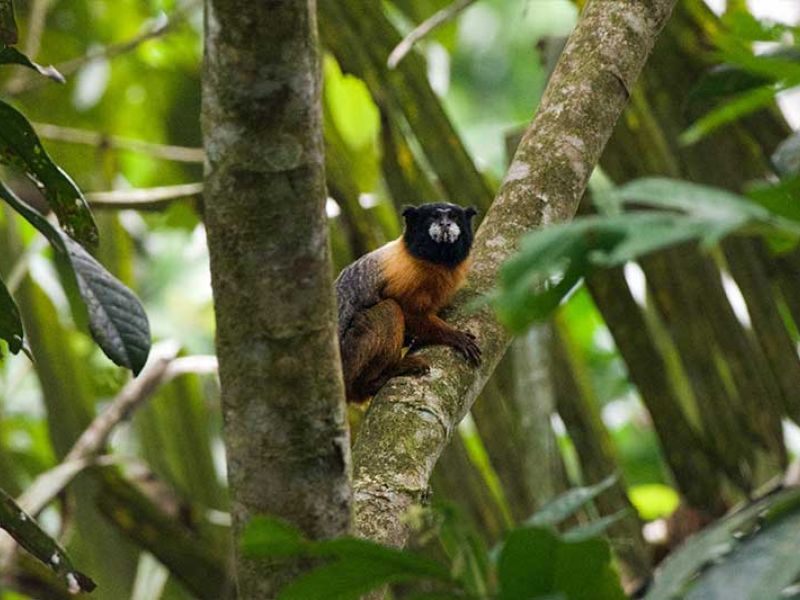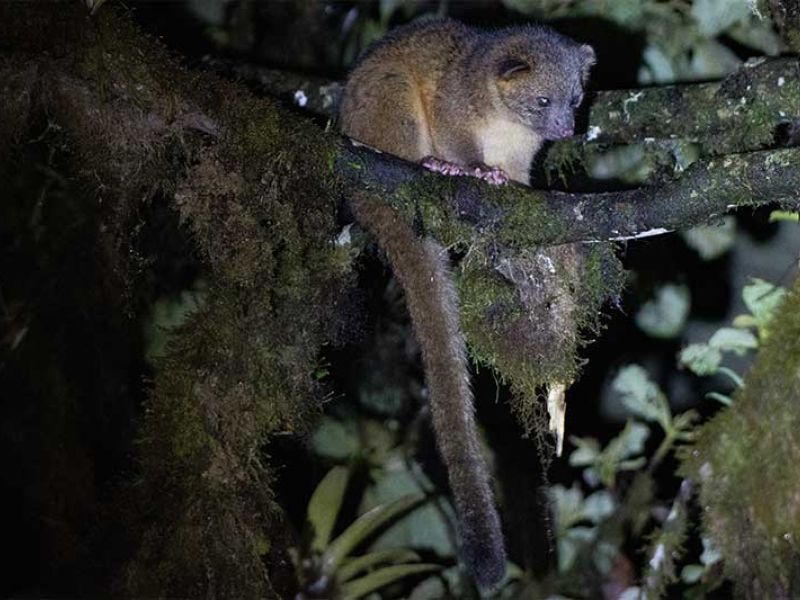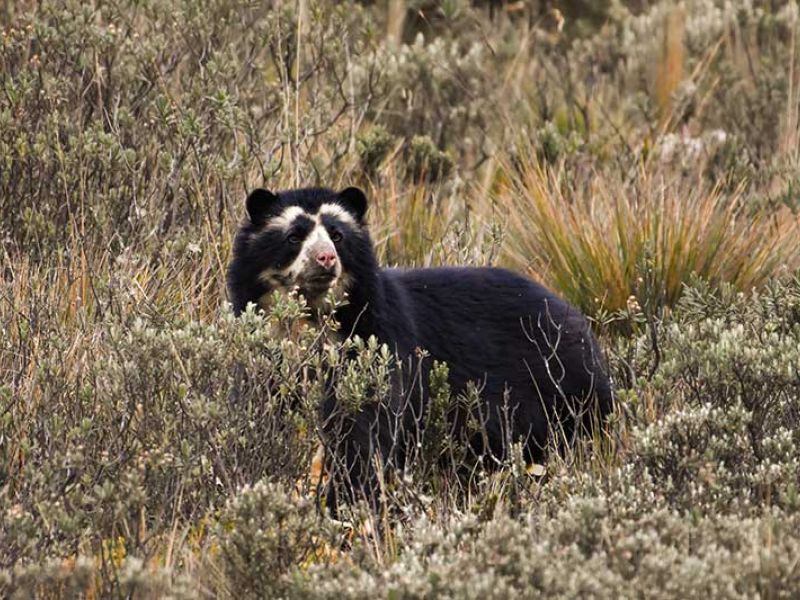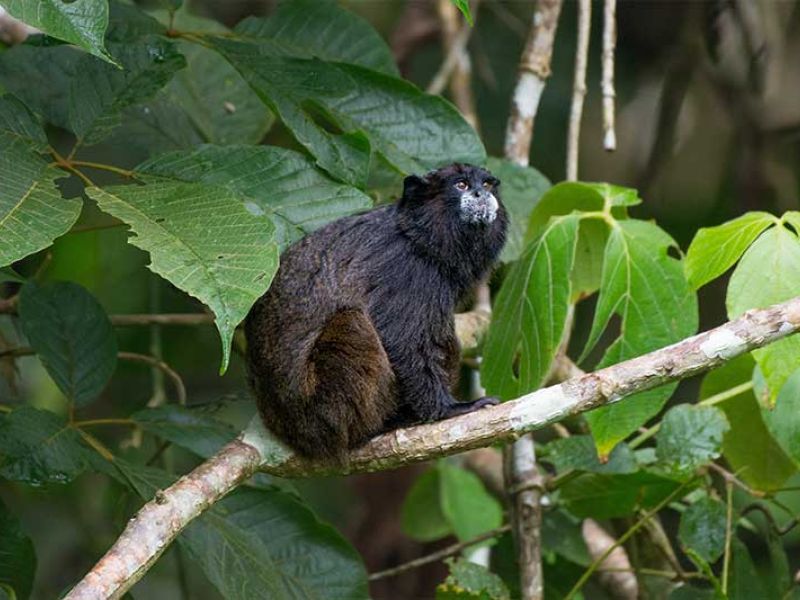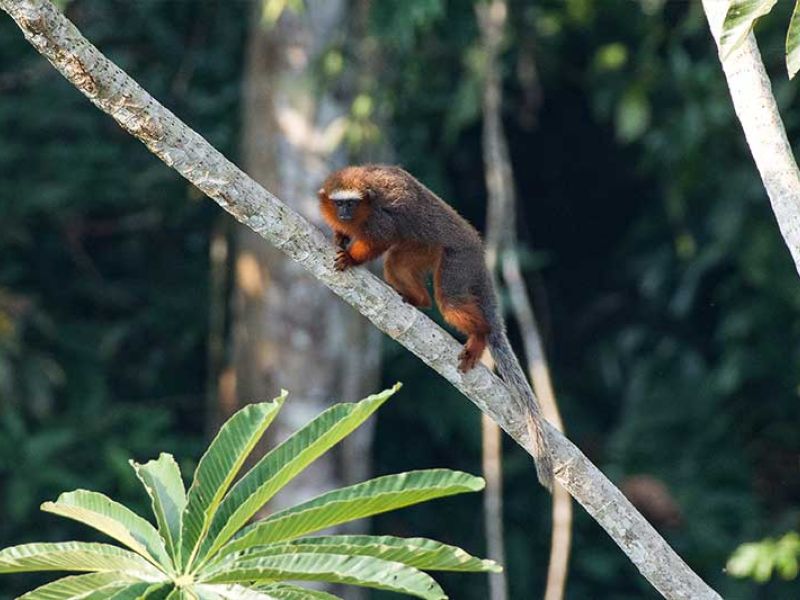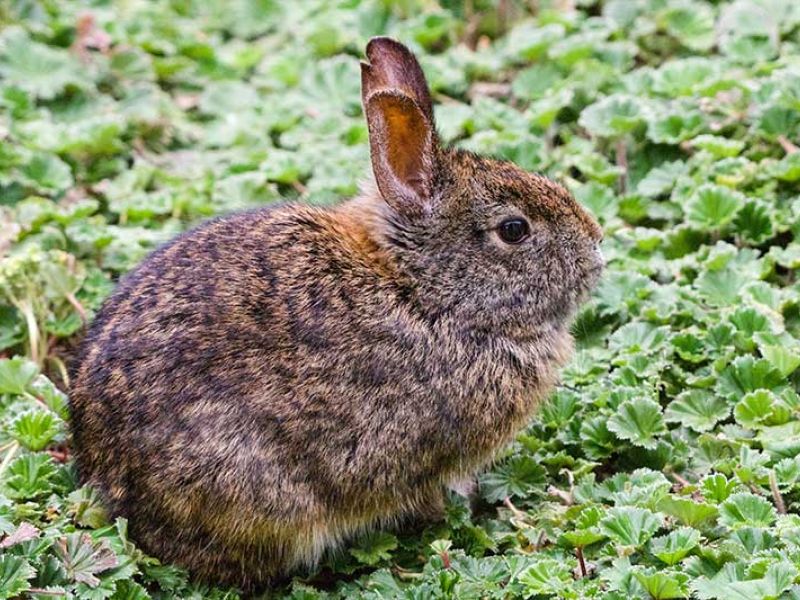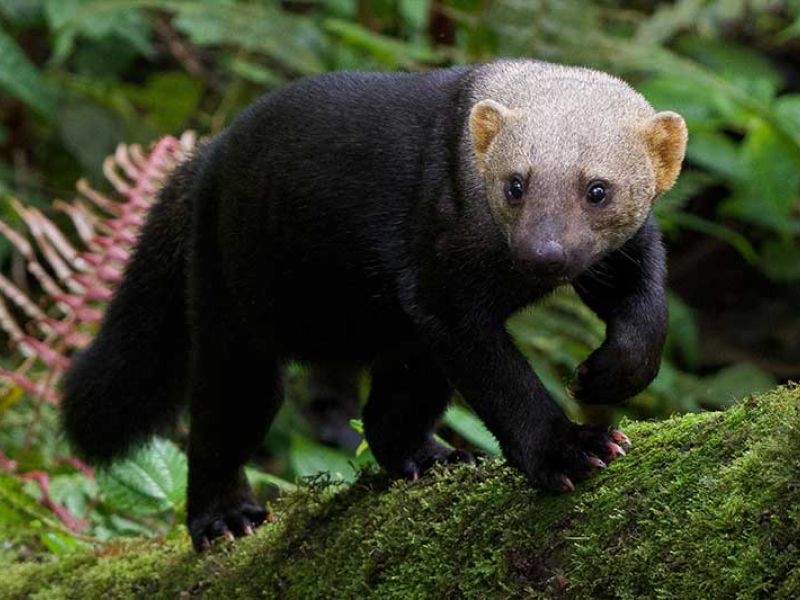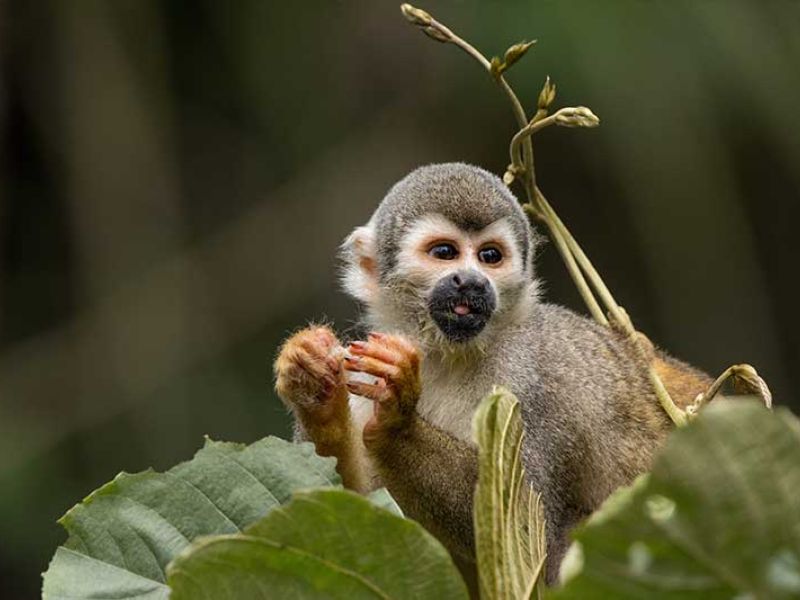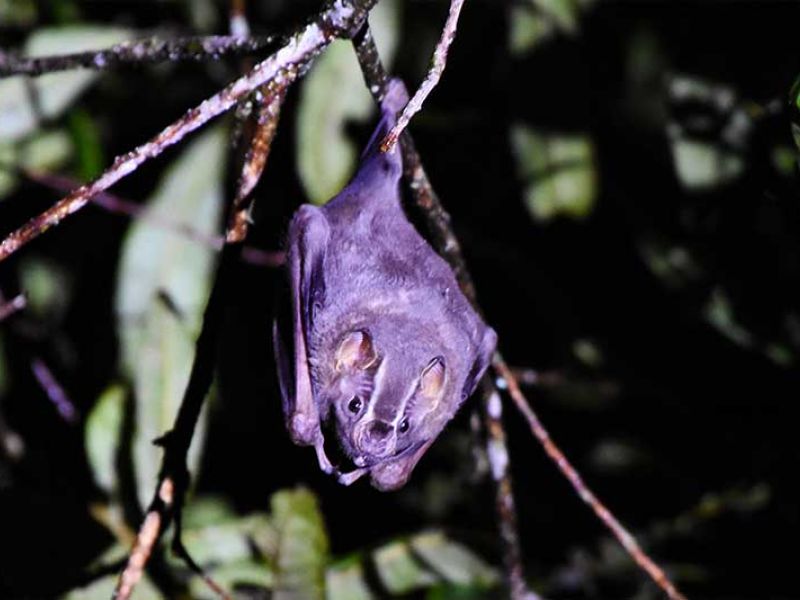Tour Information
With over 400 mammal species, Ecuador is a top destination for wildlife and nature lovers: Eleven days, ten nights.
Ecuador is the country of the enchanted islands, magnificent mountains and volcanoes, of course the Amazon rainforest of Yasuni and one of the most intriguing and mystical cloud forests on the planet.
The Andes of Ecuador is home to the unique "Spectacle" or Andean bear, the only bear species in South America. The region that we will be focusing on is divided by the eastern and western cordillera, which creates unique microclimates, magical lakes, dry forests, grasslands and stunning volcanoes. An astounding experience in biodiversity will surprise you on every step you take in this excursion.
Ecuador is also home to the most biodiverse cloud forest on earth, due to altitudinal gradients, rare and mythical creatures like the Olinguito, Pinocchio Rain fog and the rare Colombian night monkey can be found here.
This itinerary has selected the most suitable eco lodges, reserves and farms to access the habitats of the most iconic mammals in the high Andean forest, cloud forests including the foothills to maximize our opportunities to see as many species as possible within a short period of time.
Lowest elevation at Maquipucuna 1,100m/3,608ft above sea level and highest is at Papallacta 4,200m/13,780ft.
Day 1:
Arrival to Quito the capital of Ecuador: Where you will meet your naturalist guide, after an introduction to the country you will be transferred to the hotel near the airport. "Hotel Casa del Viajero" for dinner and overnight.
Day 2:
Full day exploring Cayambe Coca National Park, searching for Spectacled bears, Mountain tapirs.
Traditional Ecuadorian breakfast, 7:00am.
8:00am. We start our nature experience with a leisurely drive to Papallacta, exploring this unique ecosystem covered with grasslands, elfin forest and small bushes. Our morning drive presents us with a great opportunity to look for Andean bear (tremarctos ornatus), Condors, Andean foxes and White tailed Deer. During this expedition, we will take short walks on secondary roads to check several spots that the bears have been regularly visiting to feed. At the same time, you will enjoy the stunning landscapes and unique flora from the paramo and high Andean ecosystems.
Lunch will be around midday in the town of Papallacta, located in the buffer zone of the National Park.
After lunch, we will drive and take short walks along the eastern entrance to the reserve to a unique and stunning forest where the rare Mountain Tapir (tapirus pinchaque) can be seen.
Afternoon; We drive back to the town of Papallacta for dinner and overnight.
![]()
Day 3:
Exploring Papallacta Pass & Cayambe Coca National Park.
7:00am. Breakfast in the town of Papallacta, afterward we continue to explore this stunning nature reserve, home to a countless number of wildlife species due to its unique combination of ecosystems and microclimates.
The altitude varies from 600m/ 1,970ft in the province of Sucumbios to the highest point in the park 5,790m/ 18,995ft on the top of Cayambe volcano. However, we will ascend to only 4,000m/ 13,123ft on this excursion.
Today we will concentrate on the area near the eastern entrance to the park and along an old road extending from Papallacta to Pifo, combining car travel with slow hikes as we search for our target animals.
We will enjoy a delicious local lunch in Papallacta, which is noted for its trout and locro de papas soup, before we go to the western cloud forest.
Dinner and overnight at Alambi Hummingbird Garden Ecolodge.
![]()
Day 4:
Exploring the Northwest cloud forest near Mindo.
At 5:00am. Before breakfast, we start exploring the road from Nono to Mindo, internationally famous for its unique avian diversity. Today we will be searching for Oncilla (leopardus tigrinus), Tayra and Red-tailed Squirrel while enjoying the magnificent sunrise over the top of the mountains.
Breakfast is between 8:00 and 9:00am. We then go to explore the cloud forest by car and take short walks along the old road Nono to Mindo. This forest covers the western Andes slopes, with long distance views of the cloud forest peaks that will take your breath away.
After lunch at Alambi, we break for the afternoon and rest in preparation for our evening activities. Followed by a trip to the heart of the cloud forest for dinner, overnight and a night walk, tonight we will look for Kinkajous, Andean White-eared Opossums. In addition to our night walk we will stay at the first private ecological reserve in Ecuador, Bellavista, which is one of the most well protected areas located in the Andean Choco Bio-region, this is the only reliable place to search for the rare and mysterious Olinguito (bassaricyon neblina) which was discovered and described to science only in 2013 in Ecuador.
Overnight and dinner, Bellavista Lodge.
![]()
Day 5:
Exploring Mashpi Amagusa Reserve & Santadeo Feeders.
At 5:00am, leaving from Bellavista Lodge to Pacto Amagusa, breakfast will be at Amagusa reserve, around 8:00am.
Located in the heart of the Choco Bioregion, with over 130 hectares of primary and secondary forest, is a new protected important bird area (IBA) Mashpi-Pachijal. We will have an opportunity to view a wonderful variety of endemic birds, but we will focus on searching for the rare and enigmatic Mountain Coati, (nasuella olivacea), also good chances to see the Western Dwarf Squirrel and the Green Agouti.
We will arrive early in the morning to enjoy dozens of birds feeding at close distance near the main house, and will spend the day walking around the main area and driving slowly along a secondary road looking for our target mammals, which sometimes come to feed in the same location as the birds.
A delicious local lunch will be served at Amagusa. We then travel to the town of Pacto stopping along the way to view more wildlife and local flora.
Overnight and dinner at hotel la Canita in the town of Pacto.
![]()
Day 6:
Depending on what we have seen already, we may revisit Amagusa in the morning or check some of the newer sanctuaries which have been created on land owned by farmers in the region, the sanctuaries have given the landowners an economic alternative to deforestation and other destructive activities, further ensuring protection of wildlife and the ecosystem while also helping to secure a better quality of life for the people who live there.
These feeding stations and trails will help us to search for species that we haven’t had the opportunity to see yet.
After lunch in the town of Pacto, we drive towards the andean foothills.
The next two nights will be at Maquipucuna reserve. We will arrive early in the afternoon and rest in order to prepare for short evening activities.
![]()
Day 7:
Exploring the cloud forest of Maquipucuna reserve.
Maquipucuna is the biggest private reserve in Ecuador and protects more than 6.400ha/ 15.815ac. It is home to a countless number of plants, fungi and animals.
The altitude here ranges from 600m/1,968ft to 2,900m/9,514ft.
At dinner time, close to the restaurant, we may see the unique Western lowland Olingo, (bassaricyon medius), another chance to see Tayra, and we will be focused on finding the stunning Gray Four-eyed Opossum (philander opossum).
Their trail system allows us to explore a magical ecosystem full of birds, insects and unique amphibians, and we will take short night walks to search for Nine-banded Armadillos, Robinson’s Mouse-Opossums and Common short-tailed bats.
Breakfast, lunch, dinner and overnight at Maquipucuna.
![]()
Day 8:
Full day around Maquipucuna.
Breakfast around 7:00am. Afterward we will explore the reserve looking for Andean weasels, Pacas, Green Agoutis, the magnificent Andean bear and White fronted capuchin monkey “seen seasonally here”.
Lunch, dinner, and overnight will be in Maquipucuna, with a second night walk to search for our target mammals.
![]()
Day 9:
Breakfast in Maquipucuna, then transfer to San Isidro Lodge.
On the way to San Isidro, we will pass by Cayambe Coca National Park. Today we will have another opportunity to look for bears, foxes and deer, hopefully at closer distance.
Lunch will be in the town of Papallacta followed by a drive to the eastern cloud forest of San Isidro. This small Lodge is located in the picturesque Valley of Quijos, in the Napo province, where we will explore the heart of the eastern cloud forest, full of colorful birds, unique mammals, exotic orchids, and countless numbers of plants and insects.
We will arrive before dinner in San Isidro to check the hummingbird feeders and get ready for the night walk near the lodge.
We will spend two nights here expecting to find the rare and unique Colombian Night Monkey (aotus lemurinus), along with Kinkajous, Black Agoutis, Great Fruit-eating Bats, White-eared Opossums, and the rare Mountain Tapir, which comes seasonally to a salt lick in front of the lodge.
![]()
Day 10:
San Isidro Lodge and surroundings.
Breakfast at 7:00am. Afterward we drive to some other reserves nearby looking for Black-mantled tamarin and South American Coatis.
We will have a local lunch on the way back to San Isidro for dinner and overnight, our last chance to spot the rare Night Monkey.
![]()
Day 11:
After breakfast, transfer to Quito airport for your flight home or fly to the Amazon rainforest if taking the Amazon tour extension.
Ask for extensions to the rainforest, Cuyabeno Wildlife Reserve or Yasuni National Park, these are the best spots to search for wildlife from the Amazon basin of Ecuador.
Lowest elevation at Maquipucuna 1,100m/3,608ft above sea level and highest is at Papallacta 4,200m/13,780ft.
More Information
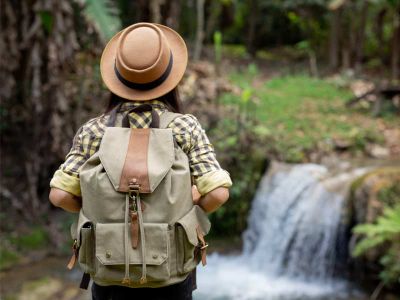
What does the Trip Include
• Airport transfers to and from UIO (International airport, Quito).
• Private transportation throughout the tour.
• English-speaking birdwatching and photography guide.
• Entrance fees to all reserves and photography hides.
• All meals for the duration of the tour.
• Coffee, tea, and purified water at all lodges and reserves.
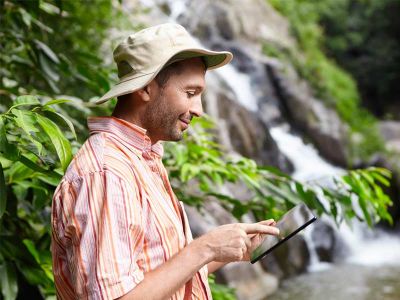
What is Not Included
• Travel insurance.
• Tips for drivers and local guides.
• Alcoholic drinks, laundry services.
• Extra services and trips not specified in the posted itinerary.
• International and local flights to Quito.

Relevant Information
• Climate is highly variable in Ecuador, with temperatures varying from 10-30°C/ 50-85°F.
Sudden rainstorms interspersed with bright sun are not uncommon.
• The official currency in Ecuador is US dollars.
• Internet is available at some lodges, but not guaranteed.
Nature Quest can arrange for the purchase of local SIM cards with advance notice in order to provide data based internet service.

Sugested Packing List
• Clothing, quick dry material; no cotton.
• Long sleeve shirts.
• Long convertible pants.
• Waterproof hiking boots or trail runners.
• Sandals or water shoes.
• Quick dry / merino wool socks.
• Sun hat or baseball cap.
• Lightweight rain jacket.
• Soft shell jacket or fleece.
• Binoculars 10x42 or 8x42.
Others: Camera, Refillable water bottle, Eco friendly sunblock, Eco friendly mosquito repellent (we suggest sawyer brand picaradin), Personal medications, Hiking poles if needed.
Additional Information for The Trip.
Guests may wish to bring their own trail cameras. If so, our local guides will advise on the best locations to set these up. Given the itinerary, the cams can only be set up for short durations, but chances will hopefully be increased by baiting the camera sites for some time before we arrive. Guests may also wish to bring infrared sensor gear. We also note recent concerns that the use of powerful lights and camera flashes may temporarily damage the sensitive eyes of nocturnal mammals. We will thus only use these techniques cautiously when needed.
Furthermore, we encourage the usage of high ISO settings on cameras and avoidance of flash wherever possible.
Please note: this trip is very focused on mammal watching. We have to drive slowly for many hours at dusk and dawn, requiring a lot of patience at the feeding stations until some animals show up.
This itinerary will be modified and changed depending on what we have seen in each location and reserve to ensure that we see more mammals in different locations according to weather conditions and latest mammals reports.
